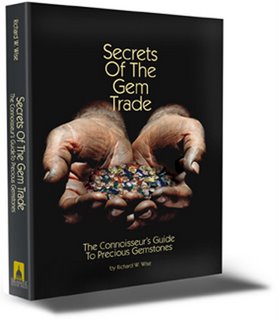LIGHT UP YOUR LIFE
Lighting and Grading Gemstones Part I
©2006
Richard W. Wise, G.G.
It used to be so simple, the brighter the light the better the light. You had the light from a fire and the light from the sun, that was it. In those good old days it was easy to figure out watt was watt! Today we have a myriad of options, “warm light”, “cool light”, “daylight.” Gem dealers are beginning to discover that the lights that make his rubies look like a pigeon's blood may make his tourmaline look like a dog's poop. As for the buyer, caveat emptor baby, check the bulb!
We are all familiar with the daylight standard: diamonds and colored gemstones are supposed to be judged in north daylight. Why?, because north daylight, specifically north daylight at
The quality of natural daylight is affected by several factors, including latitude and air quality. In addition, the relative strength and color composition of daylight changes as the day progresses. "Don't buy blue sapphire after
Color scientists measure color as a function of light temperature and express it in units called Kelvin (K). a light filament heated red will have a Kelvin temperature of 1000-1500K, orange like a candle flame has a color temperature of 1500-2500K, yellow between 2500-4000K, white as in daylight is defined as a range; 4000-10,000K. In practice, increasing Kelvin temperature reduces yellow and adds blue.
If we wish to get a true color rendering using the daylight standard we will want a bulb that produces average
Daylight equivalent lighting does exist in fluorescents but not in incandescent single point spot and flood lighting that is used by most dealers and jewelers to bring out the brilliance of a gemstone. Daylight fluorescent bulbs with Kelvin temperatures between 5500-6500 are available. These lamps are marketed, usually as “daylight” lighting by several companies under various trade names. Unfortunately fluorescent lamps generate a diffused light and produce insufficient punch, what scientists call lumens, to bring out the best sparkle in your gems. To further complicate matters, there is no recognized international standard for a daylight bulb. Each manufacturer decides for himself what to consider “daylight”.
Coming next: Part Two, Learn what types of lighting the experts favor, Stay tuned...
So, you want to learn more about lighting and judging gemstones? Read the book:
"Secrets Of The Gem Trade is very highly recommended to anyone interested in gemology as a superbly organized, authoritative, comprehensive, and easy-to-follow reference."
Midwest Book Review
April 2006




1 comment:
So I guess a sapphire that light up my my eyes at 2 pm will be beautiful 24/7?
I've read somewhere I forgot the source that rubies look their best at noon and blue sapphires look their best just before sunset. That is why I look good wearing a blue t-shirt at this time.(laughs) But I have a problem with red. The color seems to add more warmth to the already hot climate of The Philippines and at noon? And I'm the kind of person that likes to walk and wearing blue or white conditions my mind to cool my body and not sweat a lot or else I will arrive at a place looking like I just finished jogging.
And back to gems. I have a synthetic blue sapphire as claimed by the seller set in 18kt yellow gold and surrounded with fine diamonds. The sapphire look nice 24/7. It might be a royal blue or blue cornflower Kashmir sapphire and since I haven't seen a fine natural sapphire closer in person I can only guessed. Anyway most synthetic colored stones I know are the finest in terms of color. Is it?
And it is probably right that the northern lights will vary depending on where you are on the face of Planet Earth but I find the best ideal conditions for viewing gems to be around 10:30AM and 2:30PM for diamonds. 10:30AM to 12:30PM for rubies while blue saphire may look best before dusk but they kinda look pretty much the same throughout the day.
I also like looking at my diamond in the early morning. It looked ultra transparent and slightly bluish.
But most gems I've seen looked their best between 10:30 AM to 2:30PM. If only the sun is not scorching hot then I will probably be sunbathing and admiring gems all the time but unfortunately I live in the part of the World where whiter skin means " ideal beauty". And since I love me first before things then I cannot sacrifice the most beautiful thing I possess which is my skin. (laughs) And if ever I get dark after a trek to the mountains I use POND'S flawless white™ it reduces dark spots and blemishes and lightens skin in just 7 days!
Post a Comment